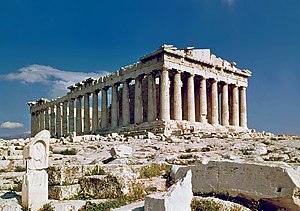Parthenon
"Temple of Athena" redirects here. For other uses, see Parthenon (disambiguation) and Temple of Athena (disambiguation).Not to be confused with Pantheon, Rome.
The Parthenon (/ˈpɑːrθəˌnɒn,
The Parthenon itself replaced an older temple of Athena, which historians call the Pre-Parthenon or Older Parthenon, that was destroyed in the Persian invasion of 480 BC. The temple is archaeoastronomically aligned to the Hyades. Like most Greek temples, the Parthenon served a practical purpose as the city treasury. For a time, it served as the treasury of the Delian League, which later became the Athenian Empire. In the final decade of the 6th century AD, the Parthenon was converted into a Christian church dedicated to the Virgin Mary.
After the Ottoman conquest, it was turned into a mosque in the early 1460s. On 26 September 1687, an Ottoman ammunition dump inside the building was ignited by Venetian bombardment. The resulting explosion severely damaged the Parthenon and its sculptures. From 1800 to 1803, Thomas Bruce, 7th Earl of Elgin removed some of the surviving sculptures, now known as the Elgin Marbles, with the alleged permission of the Turks of the Ottoman Empire.Since 1975 numerous large-scale restoration projects have been undertaken; the latest is expected to finish in 2020.
Function
Although the Parthenon is architecturally a temple and is usually called so, it is not really one in the conventional sense of the word. A small shrine has been excavated within the building, on the site of an older sanctuary probably dedicated to Athena as a way to get closer to the goddess, but the Parthenon never hosted the cult of Athena Polias, patron of Athens: the cult image, which was bathed in the sea and to which was presented the peplos, was an olivewood xoanon, located at an older altar on the northern side of the Acropolis.
The colossal statue of Athena by Phidias was not related to any cult and is not known to have inspired any religious fervour. It did not seem to have any priestess, altar or cult name.[ According to Thucydides, Pericles once referred to the statue as a gold reserve, stressing that it "contained forty talents of pure gold and it was all removable". The Athenian statesman thus implies that the metal, obtained from contemporary coinage, could be used again without any impiety. The Parthenon should then be viewed as a grand setting for Phidias' votive statue rather than a cult site. It is said in many writings of the Greeks that there were many treasures stored inside the temple, such as Persian swords and small statue figures made of precious metals.
Archaeologist Joan Breton Connelly has recently argued for the coherency of the Parthenon's sculptural programme in presenting a succession of genealogical narratives that track Athenian identity back through the ages: from the birth of Athena, through cosmic and epic battles, to the final great event of the Athenian Bronze Age, the war of Erechtheus and Eumolpos. She argues a pedagogical function for the Parthenon's sculptured decoration, one that establishes and perpetuates Athenian foundation myth, memory, values and identity. While some classicists, including Mary Beard, Peter Green, and Garry Wills have doubted or rejected Connelly's thesis, an increasing number of historians, archaeologists, and classical scholars support her work. They include: J.J. Pollitt, Brunilde Ridgway, Nigel Spivey, Caroline Alexander, and A. E. Stallings.




Tidak ada komentar:
Posting Komentar